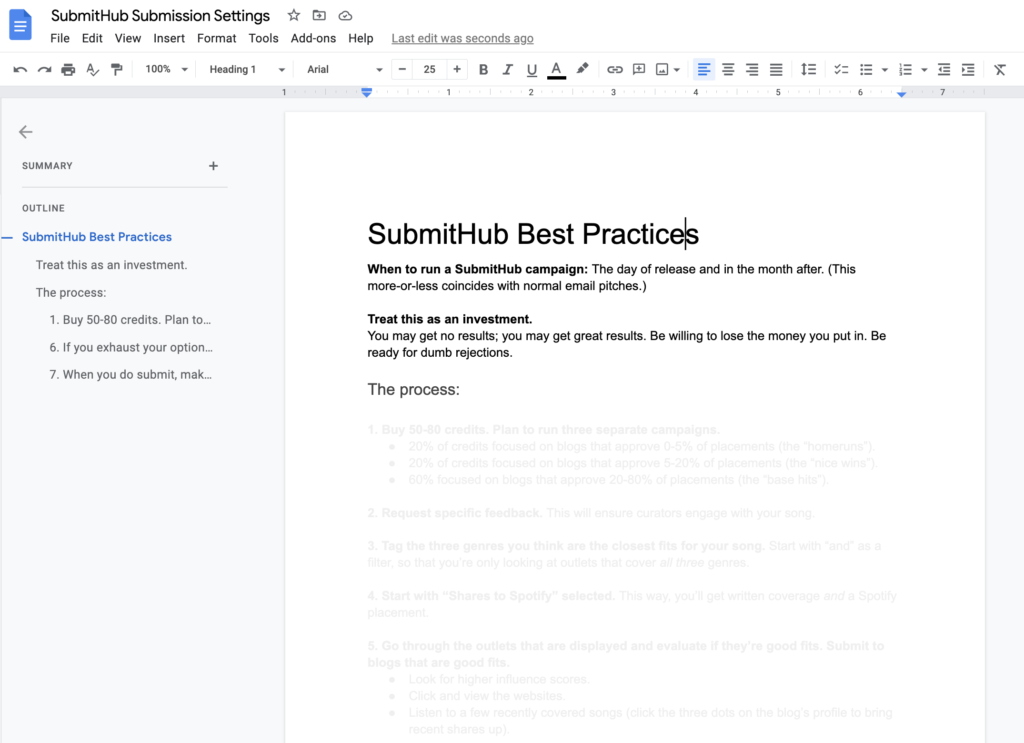SubmitHub.
It’s a controversial platform, I know.
Maybe you love it. Maybe you hate it. Maybe you hate that you love it. All of those reactions are totally understandable.
I’ve been on SubmitHub as a curator for the last five years, and over that span I’ve run dozens of my own campaigns and the full gamut of emotional responses toward the platform, myself.
A quick timeline (which I’ve decided, for vanity’s sake, to write in the third person)…
2018: Jon gets Two Story Melody approved as a SubmitHub curator and convinces himself that he will soon be a full-time music blogger thanks to the money that will inevitably rain down from reviewing artists’ submissions. Jon loves SubmitHub.
2018, one month later: Jon realizes that reviewing artists’ submissions is like having 50 Girl Scouts ring your doorbell asking if you’d like to buy their cookies, one after the other, and having to explain to 49 of them why you don’t like their cookies and won’t give them any money, at which some of them cry, some of them get angry, and all of them break your heart. A month of this earns Jon nearly $30.
Jon hates SubmitHub.
2019: Jon dupes someone else into reviewing all of Two Story Melody’s SubmitHub submissions. Jon loves SubmitHub.
2020 (I think): Jon gets Tom to write this article reviewing SubmitHub. Jason Grishkoff, the founder of SubmitHub, likes the article and links to it from a main page on SubmitHub. Jon loves SubmitHub and feels personally affirmed.
2020: After years of running PR campaigns for other artists, Jon submits his own music on SubmitHub and gets to feel what it’s like to be one of the 49 rejected Girl Scouts. Jon hates SubmitHub.
2022: Jon realizes that pretty much every time he wants to get blog articles published for a client, SubmitHub gets better results than when he emails his music editor contacts personally. Jon both loves and hates SubmitHub (and decides to quit doing PR).
You get the idea.
Anyway, I wanted to take this week’s post to give you a few practical thoughts on how to succeed on SubmitHub – because in 2023, I’ve actually been using it more than ever, and I’m as high on it as I’ve ever been.
Side note I probably should’ve put in earlier: If you don’t know what SubmitHub is, a) geez that timeline meant nothing to you, I’m sorry, and b) go ahead and read the review that Tom wrote – it explains the concept of the platform pretty effectively. (Nice job, Tom. Glad I duped you into reviewing our SubmitHub submissions heheh.)
Assuming that you know what SubmitHub is, I’ll start with the most helpful (and obvious) tip first:
1. Listen to the music the curator has approved before you submit your music to the curator.


You can find recent shares on the curator’s detail page (first image) or by clicking the three dots on the listing page (second image).
The best thing about SubmitHub, in my opinion, is its ridiculous level of transparency. You get soooo much information about each curator to whom you can submit – and that includes a running list of the most recent songs they’ve approved.
Take the time to listen to at least three of their recent approvals and see if your music fits in context with them. This is a super basic thing, I know. I also know that less than half of artists actually do it.
Seriously, if you go from not doing this -> doing it, I think you’ll double your average approval rate.
2. For your “Quick pitch,” show that you’ve listened to the curator’s work and put your song into context.
Don’t agonize over your pitch to curators; what matters most is the music. Some curators (playlisters, especially) barely even pay attention to the words you write.
That said, the best thing you can do with your pitch is give the curator a push in the right direction. When I submit to playlist curators, for example, I’ll mention the name of the specific playlist in which I think the song would fit best. This shows that I’ve actually listened to the curator’s work – I haven’t just mass copied-pasted my pitch to every curator on the page.
And if curators happen to read the pitch, they’ll already be envisioning the song in that playlist, which puts them one mental step closer toward approving it.
Relatedly, while you can give a sentence of backstory, don’t spend all of your pitch unpacking the point of the song. That feels impersonal; many of the “backstory pitches” we get at Two Story come off as copy-and-pasted rather than tailored to our blog.
When you’ve only got 200 characters, it’s probably better to let the song speak for itself, anyway.
3. You probably don’t need to get blog write-ups for every song you release.
I guess this isn’t a SubmitHub-specific tip, but I think this is as good a place as any to share it: I’ve increasingly come to believe that you should really only run one (or at most, two) press campaigns per year.
The truth is that blog articles don’t drive new fans to your music. They do have significant value; they build credibility, they help to develop your artist story, and they give your current fans context for becoming bigger fans.
But that value isn’t dependent on having a million articles from underground indie blogs. Really, you only need a few fairly recent, high quality articles to get the job done; you can reap all of the good parts of press without getting an article written about every song.
Again, as someone who’s run a ton of press campaigns professionally, my advice is to focus on refreshing your blog coverage once every year or so.
4. Try different genres, moods, and similar artists on your SubmitHub filter.
The SubmitHub filter is, in my opinion, the best in the game at helping you match your music to the right curators – but it can sometimes cause your selection of curators to become a bit too targeted.
If you’ve run through your listing page of curators and only found three or four curators you feel are worth a submission, then go back and mess with the genres, moods, and similar artists you’ve selected.
Often, you’ll find better options on your second or third try.
5. Select “Specific and honest feedback” and then ignore every word of it.
Asking for specific feedback is a way to prod curators to engage more deeply with your song – and deeper engagement tends to lead to more approvals.
Asking for specific feedback is also a way to get a ton of irrelevant, internally inconsistent, stupid advice on how to make your song better.
Trust me on this one: You want curators to give you feedback, but you also want to remember that curators don’t know what the heck they’re talking about.
6. Don’t spend a ton of money.
This bit of advice actually comes straight from the mouth of Jason Grishkoff, the founder. I’ve asked him directly how much he thinks artists should spend on his platform, and his answer caught me off guard:
$20.
(I’ve typically advised artists to spend $80.)
The thinking, according to Jason, is that you should test the waters before running an expensive campaign. Start with a small spend and see what kind of engagement you get; then, if the results justify it, spend more.
In the terms of Jim Collins’ violently-phrased business advice, fire bullets, then cannonballs.
Okay, let’s cap things there.
Hopefully this stuff is helpful as you think through running your own SubmitHub campaign… and yes, my view is that you probably should think through running your own SubmitHub campaign.
It’s worth $20 for your next release. (And you can spend even less if you use my coupon for 10% off here.)
No, the platform doesn’t house the biggest Spotify playlist curators – but it does have a ton of legitimate, engaged curators who can get you meaningful streams, and, unlike many other platforms, SubmitHub offers you the ability to build real relationships with the people to whom you submit your music. Plus, in my opinion, it’s the current gold standard for getting blog coverage as an indie artist. And also, it’s cheap.
So yeah, use SubmitHub. It’s got a lot going for it. Jason, the founder is cool. The platform itself is solid. The results can be meaningful. I love it.
I’ll probably hate it tomorrow, though.









